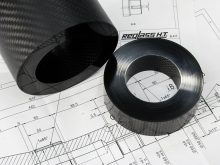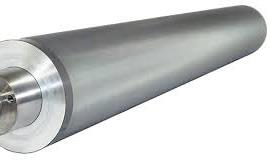Rollers for flexographic and rotogravure
Carbon fibre rollers for flexographic printing allow production efficiency, constant quality and the possibility of rapid process changes, that are the most important features in the machinery sector for flexographic printing and rotogravure. There are various possibilities for the application of carbon rollers on these machines:
- In both printing technologies, it’s possible to replace a good part of the idle and guide rollers with rollers of composite carbon fibre material. Given their low inertia, they ensure a soft dragging without stress or scratches on the printed film, and therefore a final product of excellent quality.
- With flexographic printing it’s possible to substitute printing and anilox steel cylinders with carbon sleeve holders. This can greatly increase the speed and printing requirements, especially with difficult clichés.
Rollers intended for digital printing have recently been introduced. Their small dimensions allow the production of extremely reduced batches.
Clichè rollers and sleeve holder mandrels

Around these, the printing process turns. A carbon fibre mandrel (with the standard elastic modulus also) represented a substantial innovation in comparison to the steel mandrel. Equal in stiffness, it has, in fact, a decidedly lower weight, allowing it to obtain a much higher frequency. Even better working is carbon spindle with high elastic modulus. In addition to reducing weight, it increases rigidity, as opposed to steel. Reglass creates cliché holder cylinders and sleeve holder spindles, with diameters up to 420mm and table lengths up to 6m.
Anilox rollers
They receive ink from the reservoir through the doctor blade, transferring it to the cliché in a unvarying manner. Normally they are subjected to a complex exchange of stresses, triggered by the vibrations of the cliché cylinder. Thanks to Reglass technology these are greatly reduced, thereby avoiding repercussions in the distribution of the ink, with the added advantage of lower wear and tear. Reglass produces anilox rollers which, together with clichè rollers, enable unsurpassed performance in flexographic printing.

